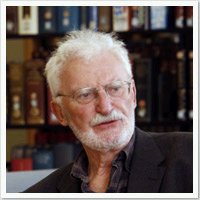Heinrich Rohrer(6 June 1933 – 16 May 2013) was a Swissphysicistwho shared half of the 1986Nobel Prize in PhysicswithGerd Binnigfor the design of thescanning tunneling microscope(STM). The other half of the Prize was awarded toErnst Ruska.[2][3][4][5]TheHeinrich Rohrer Medalis presented triennially by the Surface Science Society of Japan withIBM Research – Zurich,Swiss Embassy in Japan, and Ms. Rohrer in his memory.[6][7]The medal is not to be confused with the Heinrich Rohrer Award presented at the Nano Seoul 2020 conference.[8]
Heinrich Rohrer | |
|---|---|
 Heinrich Rohrer in 2008 | |
| Born | 6 June 1933[1] Buchs, St. Gallen,Switzerland |
| Died | 16 May 2013(aged 79) Wollerau,Switzerland |
| Known for | Scanning tunneling microscope[1] Scanning probe microscopy |
| Awards | EPS Europhysics Prize(1984) King Faisal Prize(1984) Nobel Prize in Physics(1986) Elliott Cresson Medal(1987) Fritz London Memorial Lecture(1992) |
| Scientific career | |
| Fields | Physics |
| Institutions | University of California, Santa Barbara Tohoku University |
Biography
editRohrer was born inBuchs, St. Gallenhalf an hour after his twin sister. He enjoyed a carefree country childhood until the family moved toZürichin 1949. He enrolled in theSwiss Federal Institute of Technology(ETH) in 1951, where he was student ofWolfgang PauliandPaul Scherrer.His PhD thesis was supervised by P. Grassmann who worked oncryogenic engineering.Rohrer measured the length changes of superconductors at the magnetic-field-induced superconducting transition, a project begun by Jørgen Lykke Olsen. In the course of his research, he found that he had to do most of his research at night after the city was asleep because his measurements were so sensitive to vibration.
His studies were interrupted by his military service in the Swiss mountain infantry. In 1961, he married Rose-Marie Egger. Their honeymoon trip to theUnited Statesincluded a stint doing research on thermal conductivity of type-II superconductors and metals with Bernie Serin atRutgers UniversityinNew Jersey.
In 1963, he joined theIBMResearch Laboratory inRüschlikonunder the direction ofAmbros Speiser.The first couple of years at IBM, he studied Kondo systems with magnetoresistance in pulsed magnetic fields. He then began studying magnetic phase diagrams, which eventually brought him into the field of critical phenomena.
In 1974, he spent asabbaticalyear at theUniversity of CaliforniainSanta Barbara, Californiastudyingnuclear magnetic resonancewith Vince Jaccarino and Alan King.[citation needed]
Until 1982 he worked on the scanning tunneling microscope. He was appointedIBM Fellowin 1986, and led the physics department of the research lab from 1986 until 1988. Rohrer was elected as an honourable member of theSwiss Physical Societyin 1990 and an honorary academician ofAcademia Sinicain 2008.[9]
Death
editRohrer died of natural causes on 16 May 2013 at his home inWollerau, Switzerland,aged 79.[10][11]
References
edit- ^abGerber, Christoph(2013)."Heinrich Rohrer (1933–2013) Co-inventor of the scanning tunnelling microscope".Nature.499(7456): 30–31.Bibcode:2013Natur.499...30G.doi:10.1038/499030a.PMID23823788.
- ^Heinrich Rohreron Nobelprize.org,accessed 20 April 2020 including the Nobel Lecture, December 8, 1986Scanning Tunneling Microscopy – From Birth to Adolescence
- ^Weiss, P. S. (2013)."Dr. Heinrich Rohrer (1933–2013), Founding Father of Nanotechnology".ACS Nano.7(6): 4693.doi:10.1021/nn402978h.PMID23799298.
- ^Weiss, P. S. (2007)."A Conversation withDr. Heinrich Rohrer: STM Co-inventor and One of the Founding Fathers of Nanoscience".ACS Nano.1(1): 3–5.doi:10.1021/nn7001294.PMID19203123.
- ^Robinson, A. L. (1986). "Electron Microscope Inventors Share Nobel Physics Prize: Ernst Ruska built the first electron microscope in 1931; Gerd Binnig and Heinrich Rohrer developed the scanning tunneling microscope 50 years later".Science.234(4778): 821–822.Bibcode:1986Sci...234..821R.doi:10.1126/science.234.4778.821.PMID17758103.
- ^"The Heinrich Rohrer Medal".Heinrich Rohrer Medal.Japan Society of Vacuum and Surface Science.Retrieved12 February2020.
- ^"Heinrich Rohrer Medal".The 9th International Symposium on Surface Science.Japan Society of Vacuum and Surface Science.Retrieved12 February2020.
- ^"Leadership And Development Award".Nano Seoul 2020.Archived fromthe originalon 24 February 2020.Retrieved24 February2020.
Nano Seoul 2020 appreciates the effort of gathering the professionals by presenting a Heinrich Rohrer Award.
- ^"Heinrich Rohrer".Academia Sinica.Retrieved3 December2019.
- ^"Heinrich Rohrer dies at 79; a father of nanotechnology".LA Times.2013-05-24.Retrieved25 May2013.
- ^Heinrich Rohrer obituary, The Economist June 2013
External links
edit- Heinrich Rohreron Nobelprize.orgincluding the Nobel Lecture, December 8, 1986Scanning Tunneling Microscopy – From Birth to Adolescence